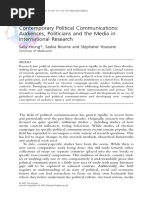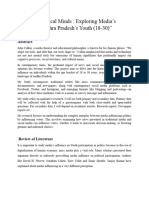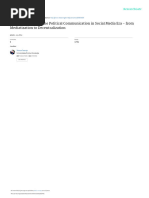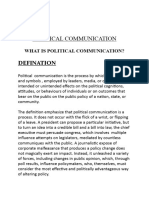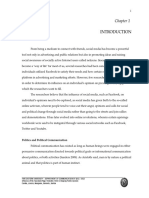Unit 1
Unit 1
Uploaded by
shreyagarg0502Copyright:
Available Formats
Unit 1
Unit 1
Uploaded by
shreyagarg0502Original Title
Copyright
Available Formats
Share this document
Did you find this document useful?
Is this content inappropriate?
Copyright:
Available Formats
Unit 1
Unit 1
Uploaded by
shreyagarg0502Copyright:
Available Formats
Political Communication
GISELA GONÇALVES
University of Beira Interior, Portugal
The concept of political communication refers to both a set of professional practices
and a theoretical and scholarly discipline. As a professional practice, the term “politi-
cal communication” suggests a series of communication processes that have been given
labels as varied as propaganda, electoral marketing, political marketing, political cam-
paigning, and political public relations. Political communication has developed into an
academic field of inquiry, with foundations in theories and methods from communi-
cation, political science, sociology, psychology, marketing, history, rhetoric, and other
fields. Its multidisciplinary nature explains the difficulty in finding a straightforward
definition. But it is agreed that political communication focuses on interaction between
political actors, the media, and citizens, which is marked by its persuasive and strategic
character.
The question posed by Lasswell (1927) on the effects of propaganda in the United
States—“who says what to whom via which channels with what effects?”—is shared
by a great deal of research in the political communication field. This simple question
imposes and highlights the basic lines of analysis for the communication process in
general and political communication in particular. Talking about who means analyz-
ing the communicator, who controls the information. Content analysis of the messages
makes it possible to find answers to what, and media analysis, which may involve a direct
medium, using political advertising (e.g., posters or leaflets), or an indirect medium
(e.g., editorials or opinion pieces in newspapers or on TV), reveals the channels used in
the communication process. Effects analysis, a field that has been widely explored, par-
ticularly in North American literature regarding political campaigns, makes it possible
to study the impacts of the communication process on audiences (whom) and normally
focuses on voting behavior (using polls, for instance).
The Lasswell communication model assumes that the communicator always intends
to influence the receiver, that all messages have effects, and that the process is unilateral
in the downward direction. For a long time in history, political communication was in
fact seen simply as a linear process of information transmission from political actors, as
parties or candidates to citizens, which could be direct but also mediated by the media.
As is shown in Figure 1, we see the direction of communication being caught by the
media and then channeled out again, what is now known as the mediatization process.
However, from this traditional point of view little or no communication takes place in
the upward direction, that is from social groups to the political sphere.
Nonetheless, thanks to the democratization of most political systems, the nature of
political communication has changed. Political communication shifted to the public
The International Encyclopedia of Strategic Communication. Robert L. Heath and Winni Johansen (Editors-in-Chief),
Jesper Falkheimer, Kirk Hallahan, Juliana J. C. Raupp, and Benita Steyn (Associate Editors).
© 2018 John Wiley & Sons, Inc. Published 2018 by John Wiley & Sons, Inc.
DOI: 10.1002/9781119010722.iesc0129
2 P O L I T I CA L C O M M U N I CAT I O N
The political The public
sphere
The Citizens
media
Political parties Voters
Candidates Newspapers Social groups
Pressure groups Radio, TV
Internet
New social
movements
Figure 1 The political communication process.
Adapted from Jensen (2001).
sphere when people, mostly as a result of increased access to information, became
involved in political activity. The simple act of voting is no longer enough and voters
have become active citizens who are able to organize and become involved in political
causes, thereby developing horizontal communication among political actors and
citizens and giving rise to actions and protests that are increasingly covered by the
media.
The growing struggle for media space, whether by official elective political agents,
such as political parties or candidates, or by non-official organizations, such as new
social movements or even terrorist groups, demands more and more complex models
and theorizations to understand contemporary political communication (Lilleker,
2006). Nowadays, as shown in Figure 1, the communication process is also in the
upward direction—from public opinion to the political sphere.
The field of political communication therefore deals with the construction and
dissemination of messages that may potentially have a direct or indirect impact on
politics. Classically, political parties are the most important political organization
in political communication and policy-making processes. But they are not the
only significant organizations in the political communication context. Message
communicators may be other organizations, such as think tanks, nongovernmental
organizations such as churches, unions, environmental organizations, human rights
organizations, or other interest groups. Journalists are also very important agents in
political communication processes, as are new social movements.
Political communication research
Political actors and the production process
A significant section of political communication literature focuses on production pro-
cesses, that is the way in which messages are generated by political actors and spread
either through traditional media or “new” media, including but not limited to the con-
text of elections.
According to Norris (2000), we can consider three different communication stages,
namely regarding campaigns: pre-modern (from the mid-nineteenth century to the
end of the 1950s), modern (from the end of the 1980s), and postmodern (since the
P O L I T I CA L C O M M U N I CAT I O N 3
beginning of the 1990s). While in the modern period political communication was
dominated by television, the postmodern period has seen the emergence of the Internet
as an important new player, helping transform the mass media campaign into a “hyper-
media campaign.” Obama’s presidential campaign in 2008 became known as the first
Internet election.
Several authors have devoted themselves to studying new technologies, especially
the use of the Internet not just by politicians but also by new social movements and
the media themselves, and researching the way in which it has changed both politi-
cal behavior and production of political content. Accepting Habermas’s thesis that the
advent of the mass media brought about a “re-feudalization” of the public sphere, some
authors saw the birth of the Internet as the rise of a “new public sphere” (Dahlgren &
Sparks, 1997). On the other hand, other authors defended the “normalization thesis”:
the thesis that politics on the Internet is nothing but “politics as usual,” dominated by
the traditional, offline players (Margolis & Resnick, 2000).
In the era of the “permanent campaign” (Blumenthal), political communication is
not limited to political marketing in the context of elections. Political communication
also considers the role of communication in governing, incorporating communication
activities that influence the operation of executive, legislative, and judicial bodies, polit-
ical parties, interest groups, political action committees, and other participants in polit-
ical processes. Thus a vast body of literature focuses on studying the “professionalization
of politics,” which can be seen in the establishment of a class of political consultants,
opinion poll professionals, and PR and media managers (Lilleker & Negrine, 2002).
Some are dubbed “spin doctors,” a term that has a connotation of manipulation of pub-
lic opinion. Several authors debate the consequences of the professionalization process
for the strategic communication of political parties, governors, interest groups, and even
for democracy itself.
Within a media ecosystem that sees constant technological evolution, recent work
has also generated a growing body of research on the changing structure of the news
industry, notably the economic basis of the newspaper industry and the legal structure
regulating press and broadcasting.
Media and the messages
Content analysis of the messages produced by different political agents and conveyed by
the media is a classic branch of political communication research. The biggest sources
of political communication are public speeches, televised political advertising, print
advertising, political posters, televised debates, and websites, especially during election
periods. This branch of inquiry is based on the disciplines of rhetoric or linguistics to
study the themes, metaphors, language, and political symbolism, and uses essentially
qualitative methods.
The study of political messages is more prolific in election periods. The reason for
this is certainly due to the importance associated with selecting the official represen-
tatives of democracy and concern about the quality of the messages offered to citi-
zens, who choose those representatives. Interest in the study of presidential elections
4 P O L I T I CA L C O M M U N I CAT I O N
rather than local/regional elections derives from the strong presence of North Amer-
ican researchers in the field. Some international comparative studies also stand out,
above all on topics linked to the European Union, such as European elections.
Since electoral messages are broadcast in different formats in the media, comparative
studies of the news coverage of politics are also a recurring theme. The most common
form of comparative study on news about politics focuses on the media sector of one
country in particular and deals with paid advertising, published press releases, opinion
columns in newspapers, or television reports themselves. Studying the roles that the
different media play in coverage of candidates and their electoral manifestos is also a
popular exercise. As is the phenomenon of personalization of politics in the media, the
issues of personality and celebrity have now become a part of the political landscape.
The analysis of the tone and quantity of messages carried in the information media, or,
in other words, the study of balance among parties in news coverage has always been
the focus of great attention.
The mediatization of political messages through media channels is a strong research
area and has many other approaches. One example is the study of the relationship
between politicians and journalists, especially regarding access to government infor-
mation and governments’ control over the media. There are also various studies on
the coverage that the media dedicate to political institutions belonging to different
branches: executive (presidents, governments), legislative (parliament), and judicial
(courts). Another recurring topic that can be the object of a comparative study, often
from a diachronic perspective, is the agenda-setting reporting of policy issues and the
representation of social minorities in the news media in recent decades. The study of
agenda-setting extends to many other issues, such as the coverage given to political
scandals. The impact of negative publicity on election results is also a popular research
focus.
The effects and the people
The study of the potential effects of exposure to different types of political messages
has been one of the most fruitful fields of research in political communication. Many
authors devote themselves to understanding how the members of an audience are influ-
enced in terms of perceptions, attitudes, and behaviors when exposed to different types
of mediated messages, whether contained in an advert or a news story. Some researchers
study the impact on perception and opinion regarding political themes (knowledge of
the themes or recognition of a political leader), others on political attitudes and political
values (support given to a particular party or cause) or on political behavior (i.e., voting
intention).
Mass communication theories have inspired a significant number of political infor-
mation processing studies. Agenda-setting theory has proven to be one of the most
robust theories (McCombs & Shaw, 1972). The core assumptions of this theory are that
the media do not tell us what attitudes or opinions we should have (what to think), but
they do tell us which issues we should be focusing on (what to think about). This means
that by seeing an issue covered in the news media—and seeing it covered repeatedly
and with great emphasis—we come to share with the media the view that the issue has
P O L I T I CA L C O M M U N I CAT I O N 5
legitimacy and thus place it on our own mental agendas. Agenda-setting is therefore
the creation of public awareness and concern with salient issues by the news media.
The assumption that the media agenda precedes the public agenda is a view close to
gatekeeping theory. This theory emphasizes the role of editors in opening the “gates” to
only certain stories or themes, which are those that join the media agenda and therefore
reach the public. Several authors have also linked research on agenda-setting to media
framing studies. Research in the field of framing assesses the way in which journalists
organize the world and condition members of the audience to understand news and
events. The basis of framing theory is that the media focuses attention on certain events
and then places them within a field of meaning. The central idea behind framing is
contextualization: Framing puts information in a situational or cultural context that
delineates how people evaluate information, comprehend meanings, and take action.
Initially applied to the study of news in the press and on TV, the scope of research
in the field of agenda-setting theory has broadened to the effects of communication
in “new” media, especially the opportunities for interaction and political participation
that they provide. Some researchers have placed their hope in the Internet to increase
civic engagement, particularly among young voters. Others see new technologies as just
one more tool for the elites in power to maintain their position of hegemony.
Among many other important theories for studying the effects of the media, the spiral
of silence theory (Noelle-Neumann, 1974) and the media uses and gratifications theory
(Blumler & Katz, 1974) stand out. The spiral of silence theory suggests that people may be
silenced when media messages about public issues are at odds with their own beliefs,
even if they actually hold the majority opinion. Media uses and gratifications theory
looks into the psychological rewards of media usage (i.e., entertainment, surveillance,
and social utility). It makes it possible to analyze the effects of a political campaign from
the perspective of the public rather than the campaigner.
Methodological approaches
Examining an early twenty-first century review of specialized literature research
(Graber, 2005; Lin, 2004, pp. 70–71), five major theory traditions in political communi-
cation research and the corresponding choices of method could be identified: rhetorical
analysis of political discourse, propaganda studies, voting studies, mass media effects,
and the interplay of influence between government, press, and public opinion (Lin,
2004, pp. 70–71). The first is the tradition of rhetorical analysis in public political
discourse. This approach is generally qualitative in nature and historically and critically
examines the source of a political message (such as the speaker’s motives and styles) and
the message itself. The second is the tradition of political propaganda study during the
post–World War I to post–World War II periods. Scholars focused on how governments
used propaganda/persuasive messages to influence public opinion. Lasswell’s (1927)
quantitative analyses (content analysis) of messages generated by the government
demonstrated the power of mass political communication in forming public opinion.
Within the third tradition of research—voting studies—specialists combined a vari-
ety of quantitative and qualitative research methods (e.g., survey research, in-depth
You might also like
- Data Science MCQ Questions and Answer PDFDocument6 pagesData Science MCQ Questions and Answer PDFshrikant ilhe75% (8)
- Bakker JDR Questionnaire 230925 130641Document14 pagesBakker JDR Questionnaire 230925 130641kencana wulanNo ratings yet
- Blumler - The Fourth Age of Political Communication (2013)Document6 pagesBlumler - The Fourth Age of Political Communication (2013)Fernando GarcíaNo ratings yet
- Media Politics BookDocument183 pagesMedia Politics BookAgron KelmendiNo ratings yet
- Political CoomunicationDocument16 pagesPolitical CoomunicationemmanueldbarnabasNo ratings yet
- 2.f.2. Political CommunicationDocument10 pages2.f.2. Political CommunicationforhadronyNo ratings yet
- GoncalvesDocument10 pagesGoncalvesferenc.pordanNo ratings yet
- How Social Media Affect PoliticsDocument7 pagesHow Social Media Affect PoliticsAlexandru Cristian PoenaruNo ratings yet
- Young Et Al-2007-Sociology Compass PDFDocument19 pagesYoung Et Al-2007-Sociology Compass PDFMarissandra Helena100% (1)
- Political Participation and Social Media UsageDocument61 pagesPolitical Participation and Social Media UsageNUSRAT AZEEMANo ratings yet
- Political Communication IncludesDocument2 pagesPolitical Communication IncludesAtharva KulkarniNo ratings yet
- Mass Media and Political MobilizationDocument19 pagesMass Media and Political MobilizationGeofrey NyagaNo ratings yet
- Media and Politics: Political Communication in The Digital AgeDocument10 pagesMedia and Politics: Political Communication in The Digital AgeInternational Journal of Multidisciplinary Research and Explorer (IJMRE)No ratings yet
- what is political communicationDocument6 pageswhat is political communicationsaniyak2212No ratings yet
- Abs, Lit, Intro, Sec 2Document25 pagesAbs, Lit, Intro, Sec 2spasumar5No ratings yet
- CSF Article1Document20 pagesCSF Article1Xonny LeutscherNo ratings yet
- Political CommunicationDocument5 pagesPolitical CommunicationSana MalikNo ratings yet
- IKSZ 16 Version1 PKCDocument18 pagesIKSZ 16 Version1 PKCfadligmailNo ratings yet
- Bennett 2018Document11 pagesBennett 2018muhammad hamidNo ratings yet
- T N M P I: HE EWS Edia As Olitical NstitutionsDocument22 pagesT N M P I: HE EWS Edia As Olitical NstitutionsevasnenNo ratings yet
- Paper For The Political Marketing Symposium, University of Gloucester, Cheltenham, September 14-5, 2005Document20 pagesPaper For The Political Marketing Symposium, University of Gloucester, Cheltenham, September 14-5, 2005fadligmailNo ratings yet
- Populist Politics in ECE - SmilovDocument132 pagesPopulist Politics in ECE - SmilovantoniocaraffaNo ratings yet
- Political Communication.: Group 5 Ilyas Aditya Rahadian. Ahnaf Muhammad Hasan. Lana Rahmani RahmatDocument11 pagesPolitical Communication.: Group 5 Ilyas Aditya Rahadian. Ahnaf Muhammad Hasan. Lana Rahmani RahmatMiracle KingNo ratings yet
- Political Communication, The Media & The "Creation" of A LeaderDocument33 pagesPolitical Communication, The Media & The "Creation" of A LeaderEdgar BarseghyanNo ratings yet
- The Mass Media and PoliticsDocument2 pagesThe Mass Media and PoliticsНаталія ЯкубецьNo ratings yet
- Van Aelst Et Al 2017 - RepositoryDocument54 pagesVan Aelst Et Al 2017 - Repositoryverča opletalovaNo ratings yet
- Schudson Media As Political InstitutionsDocument23 pagesSchudson Media As Political InstitutionsMariano FernándezNo ratings yet
- Expanding The Boundaries of Political Communication EffectsDocument19 pagesExpanding The Boundaries of Political Communication EffectsAnbr AnabiaNo ratings yet
- 816 - Tuned - Out - Media ImpactDocument25 pages816 - Tuned - Out - Media ImpactИрина ЕршоваNo ratings yet
- MediaDocument17 pagesMediamoulshreeeeNo ratings yet
- The Popularization of Political CommunicationDocument23 pagesThe Popularization of Political CommunicationUsman AliNo ratings yet
- Closer To The People A Comparative Content Analysis of Populist Communication On Social Networking Sites in Pre - and Post-Election PeriodsDocument19 pagesCloser To The People A Comparative Content Analysis of Populist Communication On Social Networking Sites in Pre - and Post-Election PeriodsHasim CevikNo ratings yet
- How Does Social Media Benefit Indian PoliticsDocument12 pagesHow Does Social Media Benefit Indian PoliticsSwayam ojhaNo ratings yet
- Publishedparticipation PDFDocument23 pagesPublishedparticipation PDFPaulNo ratings yet
- Transformations of The Political Communication in Social Media Era - Tănase TasenţeDocument11 pagesTransformations of The Political Communication in Social Media Era - Tănase TasenţeAnca RaicuNo ratings yet
- Khushi AssignmentDocument14 pagesKhushi Assignmentmanshinain08No ratings yet
- Spiders, Spam, and Spyware: New Media and The Market For Political InformationDocument14 pagesSpiders, Spam, and Spyware: New Media and The Market For Political InformationfadligmailNo ratings yet
- The Third Age of Political CommunicationDocument30 pagesThe Third Age of Political Communicationraissa sanchezNo ratings yet
- The Contingency of The Mass Media's Political Agenda Setting PowerDocument22 pagesThe Contingency of The Mass Media's Political Agenda Setting Powerurosh_warheadNo ratings yet
- Paul Politics 6Document7 pagesPaul Politics 6Conie Borabo PanchoNo ratings yet
- Texto P2. Mediatization Effects On Political News, Political Actors, Political Decisions, and Political AudiencesDocument23 pagesTexto P2. Mediatization Effects On Political News, Political Actors, Political Decisions, and Political AudiencesLucía Águila MorenoNo ratings yet
- Baugut 2019 Should The Media Be More or Less PoDocument23 pagesBaugut 2019 Should The Media Be More or Less PoJoris NiteletNo ratings yet
- Coleman - New Media and Political EfficacyDocument21 pagesColeman - New Media and Political Efficacyşirvan önceNo ratings yet
- Paper. The Third Age of Political Communication Influences and FeaturesDocument16 pagesPaper. The Third Age of Political Communication Influences and FeaturesAnonymous cvgcPTfNo ratings yet
- Election Campaigning On Social Media: Politicians, Audiences, and The Mediation of Political Communication On Facebook and TwitterDocument26 pagesElection Campaigning On Social Media: Politicians, Audiences, and The Mediation of Political Communication On Facebook and TwitterTaregh KaramiNo ratings yet
- The MediaDocument4 pagesThe MediaAsk NameNo ratings yet
- Mas 721 Pol Comm-1Document34 pagesMas 721 Pol Comm-1Evang Olufemi OgundeleNo ratings yet
- Review Question TaskDocument4 pagesReview Question TaskNasra Amsyellaciba Mohd NasirNo ratings yet
- Theory of Media Politics 2017Document216 pagesTheory of Media Politics 2017gebremedhinlegese2721No ratings yet
- Tangina This!Document59 pagesTangina This!Mon Karlo MangaranNo ratings yet
- Digital Media Political Polarization and Challenges To DemocracyDocument7 pagesDigital Media Political Polarization and Challenges To DemocracyNadeem KhanNo ratings yet
- University of Szczecinski Humanistic Faculty International Relations UnitDocument13 pagesUniversity of Szczecinski Humanistic Faculty International Relations UnitYusufMemişNo ratings yet
- A Causal-Comparative Study of The Influence of Social Media On Mandaue City Citizens' Political DiscourseDocument14 pagesA Causal-Comparative Study of The Influence of Social Media On Mandaue City Citizens' Political DiscourseJaromohom AngelaNo ratings yet
- The Impact of Political Communication On Voting Behaviour: A Comparative Study in Karnataka, Kerala & Tamil NaduDocument17 pagesThe Impact of Political Communication On Voting Behaviour: A Comparative Study in Karnataka, Kerala & Tamil NaduShubham SinghNo ratings yet
- Politics LittleDocument16 pagesPolitics Littlezaurshahverdiyev98No ratings yet
- Young and Miller Political Communication (Preprint) Aug 18 2021Document78 pagesYoung and Miller Political Communication (Preprint) Aug 18 2021B RohitNo ratings yet
- Studying Political Participation: Towards A Theory of Everything?Document20 pagesStudying Political Participation: Towards A Theory of Everything?MauricioRenteriaNo ratings yet
- Media and Democracy - A Plural ApproachDocument12 pagesMedia and Democracy - A Plural ApproachhariNo ratings yet
- Mouna Ez-Zouaq (LCS) Week5 ReportDocument3 pagesMouna Ez-Zouaq (LCS) Week5 ReportEz-zouaq MounaNo ratings yet
- Electors Are From Facebook Political GeeDocument21 pagesElectors Are From Facebook Political GeeEduardo Inglés MorínNo ratings yet
- 2018014249.umar Badamasi I. Ass 5Document8 pages2018014249.umar Badamasi I. Ass 5Umar Badamasi IbrahimNo ratings yet
- ECER 2022 Call For Proposals FinDocument3 pagesECER 2022 Call For Proposals FinPratama WiryaNo ratings yet
- Game-Based LearningDocument20 pagesGame-Based Learninggreat cisseNo ratings yet
- Jurnal 1Document12 pagesJurnal 1Nurmiyati SunartoNo ratings yet
- History of HCIDocument173 pagesHistory of HCIPatrick JacintoNo ratings yet
- Sociology, Anthropology Psychology PerspectivesDocument16 pagesSociology, Anthropology Psychology PerspectivesMary Rechelle RublicoNo ratings yet
- Feature Extraction Using Rough Set TheorDocument3 pagesFeature Extraction Using Rough Set TheorTeddy BubsNo ratings yet
- Sutawidjaya Dan Asmarani, Hal.32-45 Jurnal JDM, Vol. I No.02 Sept 2018Document14 pagesSutawidjaya Dan Asmarani, Hal.32-45 Jurnal JDM, Vol. I No.02 Sept 2018Ritki SetiawanNo ratings yet
- NOUN-2024_2-E-exam-final-timetable-NounGeeksDocument6 pagesNOUN-2024_2-E-exam-final-timetable-NounGeeksbababonet360No ratings yet
- Assignment No: 2.1 Empathy: The Essence of Humanity: The Main Plans Drawn Out For The Class WereDocument8 pagesAssignment No: 2.1 Empathy: The Essence of Humanity: The Main Plans Drawn Out For The Class WereVNo ratings yet
- Chapter 2 Lesson 1Document3 pagesChapter 2 Lesson 1Mary Cassey Golosino Devibar IINo ratings yet
- Research Methodology & Biostatistics PART - I 17042051Document18 pagesResearch Methodology & Biostatistics PART - I 17042051Ziyad AbdallahNo ratings yet
- Essentials of Negotiation: Roy J. Lewicki Bruce Barry David M. SaundersDocument13 pagesEssentials of Negotiation: Roy J. Lewicki Bruce Barry David M. SaundersdiyanaNo ratings yet
- Lesson Plan SCIENCE 5 (WEEK 3, DAY 3)Document3 pagesLesson Plan SCIENCE 5 (WEEK 3, DAY 3)Angel rose reyesNo ratings yet
- 12 Anecdotal Records On ProgressDocument2 pages12 Anecdotal Records On ProgressGuia P. Buan100% (2)
- Dpit 051 Introduction To Decision SupportDocument3 pagesDpit 051 Introduction To Decision SupportMohammed KyaloNo ratings yet
- Topic 2 DQ 1 (Obj. 2.1)Document4 pagesTopic 2 DQ 1 (Obj. 2.1)Elias OjuokNo ratings yet
- TQM ppt2Document8 pagesTQM ppt2A Veda SagarNo ratings yet
- Molecular Biology of The CellDocument129 pagesMolecular Biology of The CellAndres Sanchez EscobedoNo ratings yet
- BASIC and COMMON COMPETENCIES POWER POINTDocument13 pagesBASIC and COMMON COMPETENCIES POWER POINTMarlou Chester BendañoNo ratings yet
- Jurnal Skripsi Azhar TerbaruDocument16 pagesJurnal Skripsi Azhar Terbaruazhar khoiruddinNo ratings yet
- Frederick Cooper (Editor), Randall M. Packard (Editor) - International Development and The Social Sciences - Essays On The History and Politics of Knowledge-University of California Press (1998)Document368 pagesFrederick Cooper (Editor), Randall M. Packard (Editor) - International Development and The Social Sciences - Essays On The History and Politics of Knowledge-University of California Press (1998)Laura NavalloNo ratings yet
- Francis Sam L. SantañezDocument4 pagesFrancis Sam L. SantañezFrancis Sam SantanezNo ratings yet
- Ed 401 Episode 1 5Document7 pagesEd 401 Episode 1 5May Ann OmoyonNo ratings yet
- Research Methods in PsychologyDocument21 pagesResearch Methods in PsychologySomia aliNo ratings yet
- Quality of Life ResearchDocument23 pagesQuality of Life ResearchMohamed ElserafyNo ratings yet
- International Technical Practical Experience Scholarships Year 2022/23Document2 pagesInternational Technical Practical Experience Scholarships Year 2022/23Darlic NeylahNo ratings yet
- Compre MasteralDocument2 pagesCompre Masteralsittie fatimah rubinNo ratings yet









